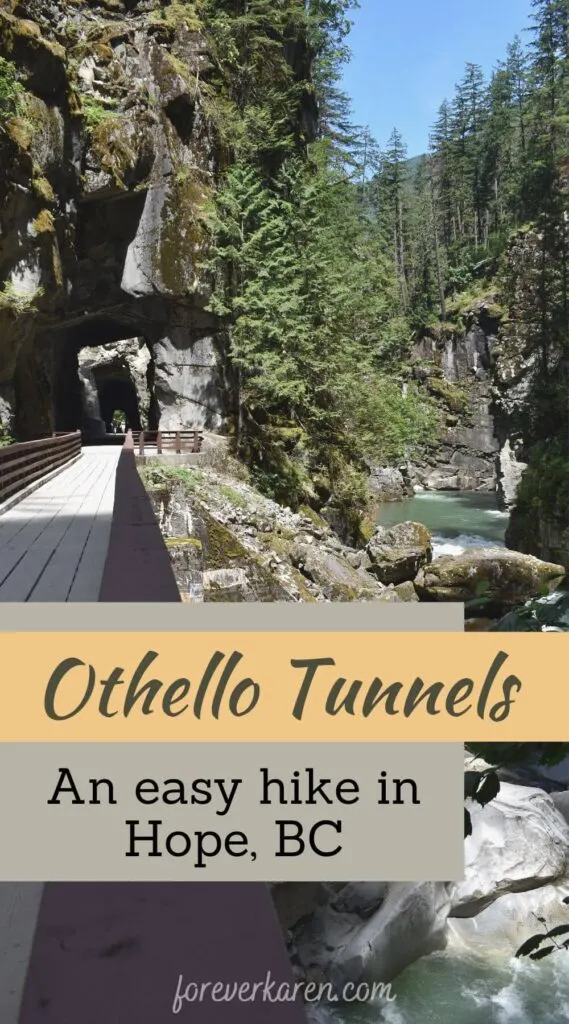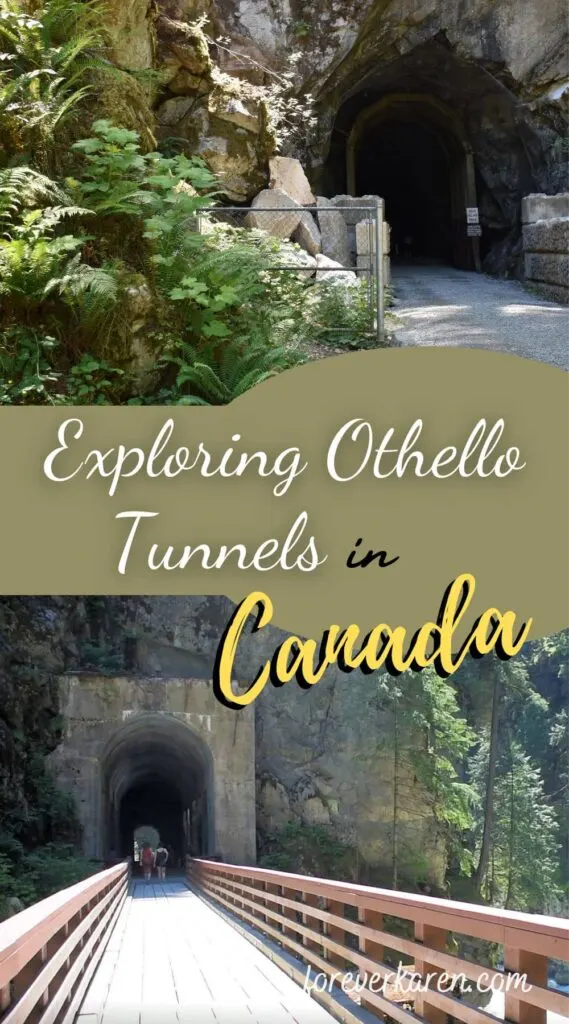
[Updated February 2022] Due to storm damage in the winter, the Othello Tunnels remain closed.
BC’s Othello Tunnels, just a couple of hours east of Vancouver, is one of those easy day trips that let you explore the outdoors and learn about local history. Located about 10 km (6 miles) outside of the small town of Hope, BC, we made the trip recently and on a beautiful sunny day.
If you’re a tourist and have three days in Vancouver, consider making the drive east. You’ll enjoy some of the Fraser Valley on the way to the historic Othello Tunnels. The tunnels, located in the Coquihalla Canyon Provincial Park, are open daily from dawn to dusk. However, the tunnels are closed during the winter due to hazardous conditions caused by snow and ice and the increased risk of falling rock.
History of Othello Tunnels
In the early 1900s, the Canadian Pacific Railway decided a route was necessary to link the Kootenay region with the British Columbia coast by rail. Andrew McCulloch was hired as the chief engineer in May 1910. Due to the challenge of boring the tunnels and building the rail line over the gorge of the Coquihalla River, this boasts the most expensive mile of railway track in the world: CAD 300,000 in 1914, which would be CAD 7.7 million today.
Cliff ladders, suspension bridges, and ropes allowed workers to complete what is, to this day, regarded as a spectacular engineering feat. The tunnels gained the name Othello Tunnels because McCulloch was an avid reader of Shakespearean literature. As a result, he named this section of the track after the Shakespearean character – Othello.
The Kettle Valley Railway was officially opened on July 31, 1916. The line operated freight and passenger service between Vancouver and Nelson, but the operation was plagued with snow and rock slides.
Filming At The Othello Tunnels
The Othello Tunnels have been used in filming several movies such as:
- First Blood used the sandbar in its scenes.
- Fire with Fire utilized the cliffs in its film.
- Far from Home – The Adventures of Yellow Dog placed an enormous log placed across the canyon for a rescue scene.
- Also, First Blood used the stump above tunnel two in the spectacular canyon jump.
- Shoot to Kill featured the cliff in its movie.
Directions To Coquihalla Canyon Provincial Park
The Othello Tunnels are just a couple of hours east of Vancouver in BC. They are found in Coquihalla Canyon Provincial Park.
Getting there is a relatively easy drive along Highway 1 (TransCanada Highway). However, the signage is somewhat poor near the tunnels, and I’d recommend using a GPS or Google Maps.
During our travels there, I missed the small weathered sign just before the tunnels and ended up arriving at Othello Tunnels Campground, which is just up the street on Othello Rd. The Campground obviously had many visitors arrive there mistakenly while trying to get to the tunnels because they had a large sign on their gate telling you to turn around and go back to the tunnels.
Othello Tunnels Parking
There is limited parking at the tunnels for approximately 50 vehicles. However, this includes some parking for tour buses. So, you are strongly encouraged to arrive as early as possible – by 10 am if possible – to ensure you can find a spot.
We visited on a weekday in June before local schools were out for the summer, and parking was not a problem. The park had been closed for 2020, and with the borders closed, few people were visiting that day. The park’s website warns that parking outside of the park can result in being towed. At least parking is FREE once you find a spot!
Othello Tunnels Trails
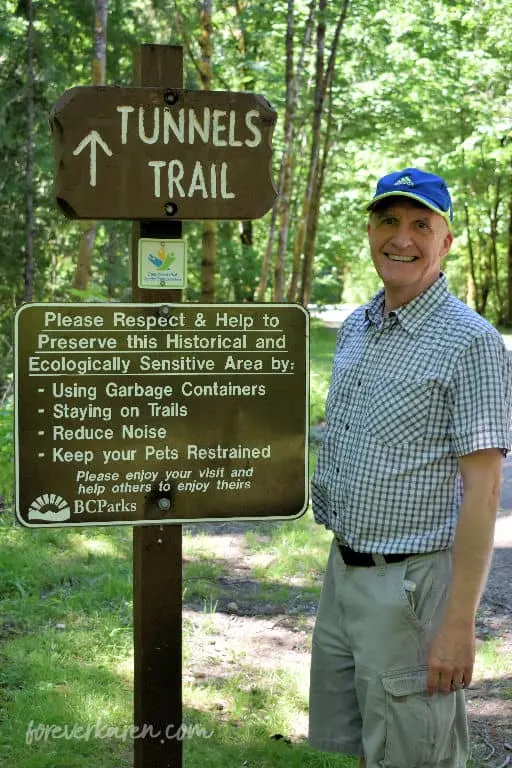
Once you’ve parked, look for the signs showing where to start the trail. You can take two routes, with one being direct to the four tunnels. Alternatively, the other provides a much longer 5.4 km (3.4 miles) loop. The longer trail starts at the parking lot, winds through the woods, and loops back around through tunnels.
The longer route would be well over an hour, so Karen and I chose the direct tunnel trail since we have already seen similar BC wilderness trails many times. For us, exploring the Othello Tunnels and the rapids below was what we came for.
The shorter trail is just 1.4 km (.9 miles) from the parking lot to the end of the tunnels. The 2.8 km (1.8 miles) route round-trip can be quickly completed within an hour, even after stopping for photos and enjoying the scenery above and below.
What to Know Before You Explore
It’s a short ten-minute walk from the parking lot to get to the first tunnel. There are minimal services at the park, with just outhouses available as restrooms. There are a few picnic tables in the area if you want to pack a lunch to enjoy before or after exploring the tunnels.
It is strongly recommended that you bring a small flashlight for your safety when walking through the longest tunnel. However, inside the tunnels, the ground is mainly sand or fine gravel and not a tripping hazard. Although we walked the trail on a warm day, there were spots where water dripped from the ceiling.
During the rainy season, I’d imagine this might create puddles so, having light prevents stepping in pools of water. I took a flashlight, but due to the bright sunlight which illuminated the ends of the tunnels, we only used it on our return hike. Alternatively, you can use your cell phone to light the way.
The Othello Tunnels trail is an easy hike and suitable for families of all ages. BC’s Othello Tunnels is pet-friendly, but you need to keep your dogs leashed at all times. This common-sense rule is both for their safety and the convenience of others enjoying the trails. We only saw one bench on the trail, so should you need to rest, there are places to sit on the rock walls between the tunnels.
The First Tunnel
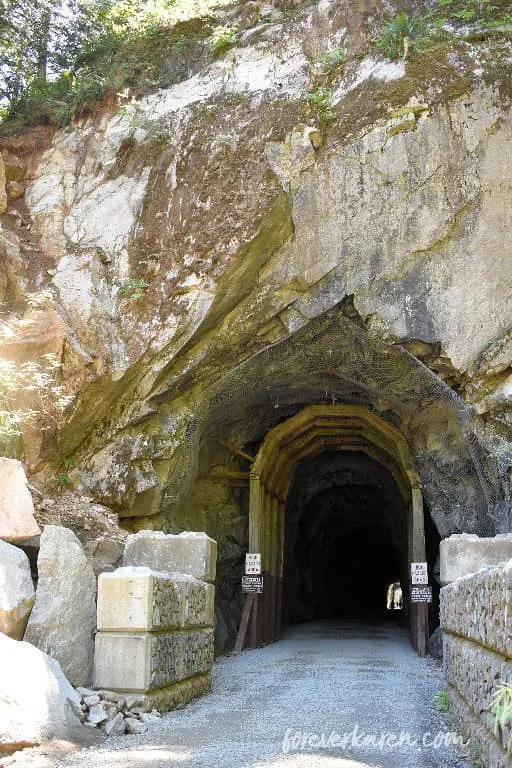
When I first arrived at the tunnels, I was impressed with the amount of rock and granite. I could only imagine how hard it would be to create the tunnels by hand through solid rock 100 years ago. The tunnels and the connecting bridges are indeed a feat of engineering that is remarkable even today.
Admiring the tunnel’s entrance, I thought the height seemed relatively low and could imagine the trains barely cleared the tunnel’s roof. Obviously, they did not use stacking boxcars as they do today.
If you pause for a moment at the entrance, you can imagine a large train a hundred years ago travelling through the foreboding tunnels. The train would blow its whistle while billowing smoke as it noisily rode through the large tunnel.
The deafening whistle would warn any animals that had accidentally wandered into the tunnel, unaware of the impending danger of the approaching locomotive.
The entrance signs instruct cyclists to dismount while riding through the tunnels. However, we noticed several riders (without headlights) speeding through the tunnels. Be cautious with pets or children if you encounter cyclists in the dark sections of the tunnels.
Of all the tunnels, the first was the longest at 556 feet and the darkest. So maybe use your flashlight if you have children. Once you reach the light at the end of tunnel one, there’s a short distance until the entrance of tunnel two.
The Other Tunnels
There is a “Quintet” (five) of tunnels, but there is only four because tunnel three and four are together resulting in a single tunnel. Shorter in length but still impressive, the second tunnel has the same remarkable sense of being cut through solid rock.
The third tunnel has “windows” or arches carved on its right side, allowing for daylight and views of the lush rainforest. The windowed tunnel gives the impression that this section has two tunnels. On the concrete pillar, the date of 1934 probably indicates the time when this concrete section was updated.
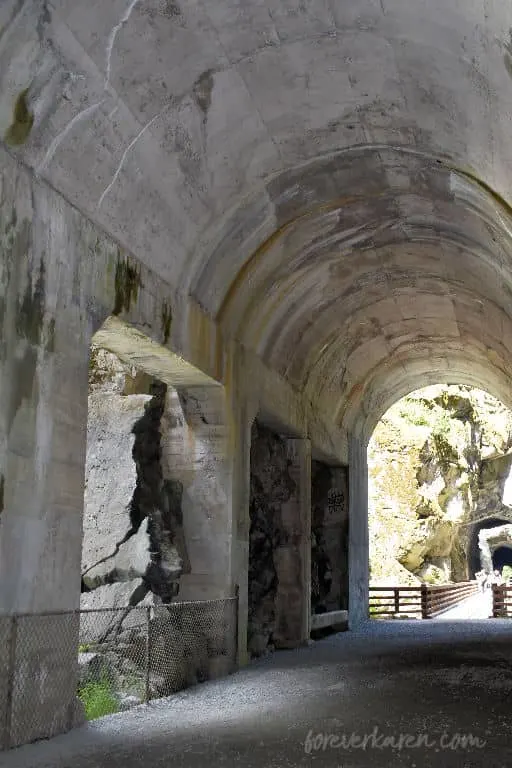

The last tunnel may seem the darkest at first glance. But at 276 feet, it curves slightly to the right preventing visitors from seeing the light at the other end. However, once you enter the tunnel and start to walk, the lighted exit will come into view. After the last tunnel, there are no barriers or fencing at the trail’s edge, making this portion hazardous. If you’re hiking with small children, do not allow them to walk alone.
From here, the trail continues through the forest and turns to the right, looping back to the parking lot. This part of the trail has a 200-metre elevation gain, and expect the looping trail to take two hours.
Love Locks
As has become a tradition in many tourist areas these days, I noticed a few locks that have been fastened to the chain-link fences installed near the bridges. These were probably placed there by young couples to symbolize their blossoming passion for everyone to see.
Similarly, Queen Elizabeth Park in Vancouver has devoted an area of the park with suitable steel artwork to provide a home for travelers to place a love lock as an enduring symbol of love.
Concrete And Rock
The constant hazard of falling rock has closed the tunnels for a couple of years. The tunnels were opened again after engineers could get the risk under control. Also, the tunnels routinely close in the winter because the risk of rock becoming dislodged is greatest when combined with the hazard of snow and ice.
However, one of the impressive features of the Othello Tunnels is the blending of concrete to reinforce the precarious rock formations. Over the past century, I’m sure there have been frequent repairs to strengthen the tunnels so they can stand the test of time.
The last tunnel is mostly concrete at its exit. Unfortunately, due to the smooth surfaces, some hikers have defaced the walls with some graffiti.
Othello Bridge Tunnels
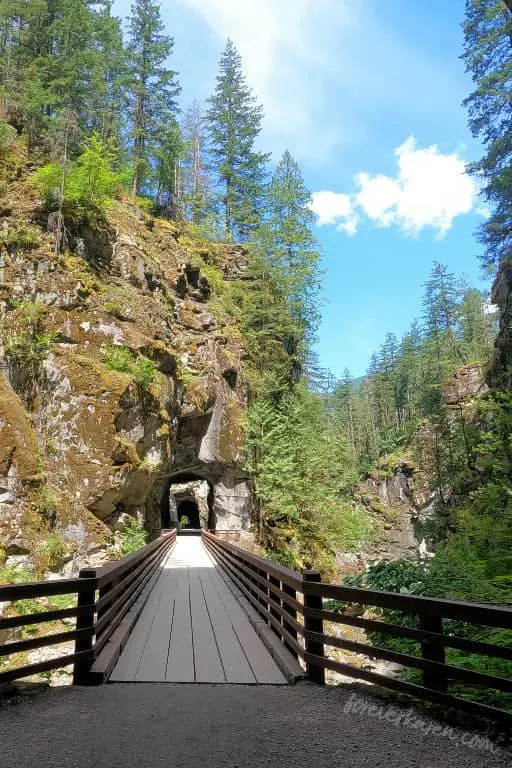
Due to the hazardous landscape caused by the raging river below, it was necessary to build two equally impressive bridges. These provided safe passage for the train between the tunnels and serve as part of the trail today.
The wooden bridges span the Coquihalla River gushing below. With the trains of yesteryear long gone, the well-maintained bridges now provide fantastic lookout points in contrast to the darkness of the tunnels.
After tunnel two, there is an excellent opening with the rapids of the Coquihalla River passing below. You can also smell the creosote from the massive railway ties, mixed with the misting moisture from the river. Together with the visual extravaganza of the rock and trees, your senses are overwhelmed.
What makes the Othello Tunnels hike so special is the surrounding scenery. The lush greenery and river rapids contrasted greatly with the large expanse of rock. Admiring the steep canyon and rushing river gave me an appreciation for the feat of engineering to construct these tunnels.
The trail makes for a great day out on a hot summer day. We visited after a 40 C+ heatwave in Vancouver. So, the cool tunnels and shady hike were quite refreshing during the hot weather.
A few individuals had climbed down the canyon to the river below on some open-air sections of the trail. It’s not advisable to do this as the canyon walls are steep and the river runs fast.
Final Thoughts
The idea for the Othello Tunnels was born over a century ago. British Columbia attempted to overcome some natural barriers caused by the Rocky Mountains. While unprecedented and very costly – even by today’s standards, Canadian Pacific Railway still built the railway tunnels. For another great train hike, “A walk in the past” in Yoho Park offers a view of some old trains and the amazing spiral tunnels through the Canadian Rockies. If you’re considering a road trip from Vancouver to Banff, plan to stop at the Othello Tunnels on the way.
Through incredible engineering and the efforts of hundreds of workers, the tunnels remain a unique destination for a short day trip not far from Vancouver, British Columbia. While hikers can complete the trail of the Othello Tunnels in just an hour, it is still an impressive look back at the history of BC.
Unfortunately, the tunnels have remained mostly closed the last few years. In 2020, the park closed due to Covid-19 and fears people could not practice social distancing. In 2021, the park opened in June, but the tunnels suffered serious storm damage in November. Still closed, BC Parks is unsure if the Othello Tunnels will reopen in 2022.
Happy Travels ~ Brian
